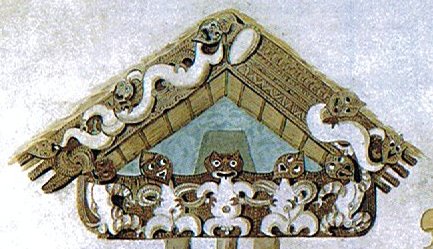Probably the Moon calendar in C was used as a way to explain for the reader not only where important 'corner stones' of the year were but also to underline the similarity in structure between the well known month and the year. Below is my basic interpretation:
The first 8 glyphs could be a kind of introduction, because there are no marama nights (days) here. Marama in Ca6-23 for instance, is drawn in another way. The first 'period' (or season) can be compared to the night of the new moon. Or better, to the 8 nights when Venus is absent from the sky before she returns as morning star. Or, more pertinent to my way of reading, the first period could illustrate the 8 decades of days to March 21 (or some other multiple of 8, e.g. 26, to July 27). The first glyph (Ca6-17) can be coordinated with manzil day 101 and with August 25 (Gregorian day 237 = 8 * 29½ + 1). A new season is evidently beginning here, where the Chinese had the 2nd star of their 26th lunar station, Extended Net. 157 is a quarter of 2 * 314. The head-gear in Ca6-24 (where we can count 62 * 4 = 248 = 8 * 31) has no longer any head to adorn. 248 = 540 / 5 + 140. The missing head can be imagined as 'buried'. ... When the new moon appeared women assembled and bewailed those who had died since the last one, uttering the following lament: 'Alas! [Aue!] O moon! Thou has returned to life, but our departed beloved ones have not. Thou has bathed in the waiora a Tane, and had thy life renewed, but there is no fount to restore life to our departed ones. Alas ...
There are 4 glyphs at the end of line a6 which evidently 'belong' to the following sequence of glyphs and together with the very special Ca7-1 and the 6 kokore nights this maybe means the period has 5 + 6 = 11 nights:
When Moon returns into view there are 6 ordinary nights 'without' (kore), i.e. with no tapu to take into consideration, no prohibitions:
Line a6 is ending with glyph 168 (24 weeks after March 21) and line a7 is beginning with Gregorian day 249 (possibly alluding to day 249 after March 21 when Antares rose heliacally). 7 * 24 = 168 nights could have been a measure to 11h. But 24 * 9 = 216 = 3 * 72, and 72 days was probably a main 'beam' in the structure of the solar year. September 2 is Gregorian day 245 and Ca6-25 can be counted either as 62 * 5 = 310 (10 months with 31 days in each) or as 6 * 25 = 150 (half 10 months with 30 nights in each). September means 'the 7th month' and September (7) 2 was possibly a reference to 72. September 13 could then allude to the fact that 13 weeks equals 91 days and in the following night of September 14 (where we can count 91 * 4 = 364) they could see σ Phoenicis, which rose heliacally in right ascension day 360 (March 16), i.e. 2 days after the Gregorian π day (3-14).
I have black-marked the 7 stars of Corvus (Raven), the first of which (Alchita) rose together with sun at right ascension 12h. In the night the brightly coloured 'bird of fire', Phoenix, could be seen. In myth these birds marked the harsh northern winter (Raven) respectively the soft and pleasant summer. I have red-marked the 22 Phoenix stars which have been given Greek letters. September 14 is 177 (= 6 * 29½) nights after March 21. September 17 is day 260 from January 1 (= 180 days from the March equinox). In Ca7-15 (at 12h) we can count 71 * 5 = 355, which means 1 day more than 12 * 29½, perhaps a sign that the dark southern winter was over - spring south of the equator could be counted from the time when sun rose together with Raven, when in the night Phoenix could be seen close to full moon. There are 15 feather signs at the back (in the past) and 15 * 12 = 180. September 20 is day 263 + 365 = 628 counted from the previous January 1. This could be a way to tell us that also the whole circumference of a circle has been completed, because 628 = 2 * 314 (meaning π). Possibly the moon night Otua was given its name ('back side'), because in rongorongo times this night was 'reflected' in a calendar as the first night beyond right ascension 12h. The front side would then end with Ohua. At left (in the past) we can see a hua, formed like a rising fish with 3 feathers high up at left and 3 feathers low down at right (and the tail of the 'Sun fish' is drawn down). Ca7-14 probably illustrates that a solar cycle has ended:
| ||||||||||||||||||||||||||||||||||||||||||||||||||||||||||||||||||||||||||||||||||||||||||||||||||||||||||||||||||||||||||||||||||||||||||||||||||||||||||||||||||||||||||||||||||||||||||||||||||||||||||||||||||||||||||||||||||||||||||||||||














